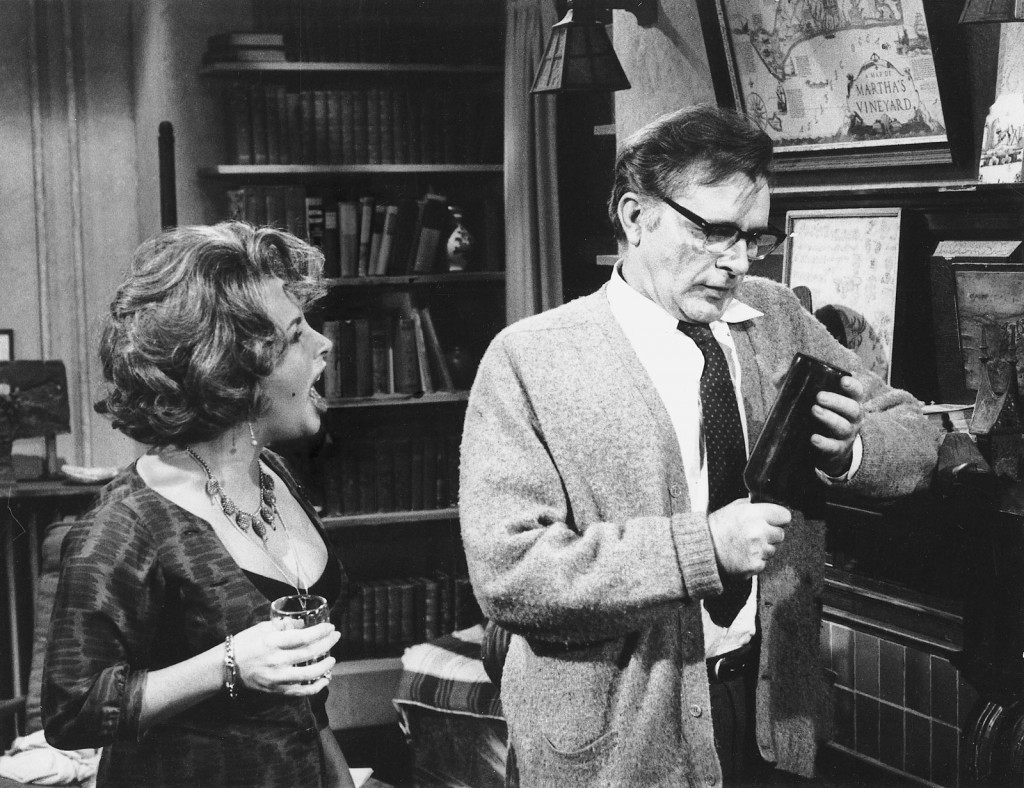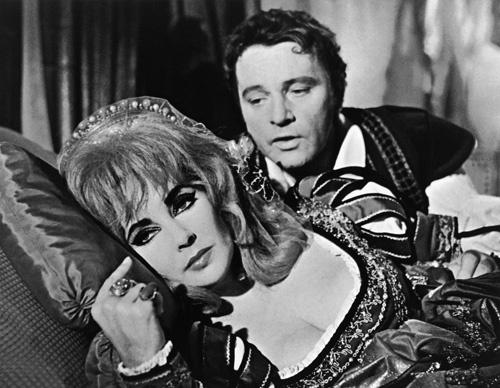With Cannes screening Cleopatra (marking its 50th anniversary) two nights ago and yesterday’s re-release screenings at 75 theaters countrywide, we’re feeling the Elizabeth Taylor and Richard Burton love. The twice-divorced, Vatican-condemned couple continues to capture the public’s imagination and interest. In the past three years, we’ve seen Sam Kashner’s Furious Love and Richard Burton’s diaries become bestsellers, Liz & Dick being the most notable thing in Lifetime’s line-up, and John le Carré writing in The New Yorker just last month about working with Burton on The Spy Who Came in from the Cold, and those are just a few things that spring to mind. Although their film collaborations have gotten a bit of a bum-rap over the years (somewhat deservedly), here are five Taylor-Burton films that we think are worth watching, out of the eleven that they made together. Feel free to share your own thoughts on these films and/or which ones you would have chosen in the comment section below.

Cleopatra (1963)
Why not begin at the beginning? This opulent epic directed by Joseph L. Mankiewicz centers around a cat-eyed, hair-braided Cleopatra (Elizabeth Taylor) and her lovers (or husbands, depending on the historian), a somewhat soppy Julius Caesar (Rex Harrison) and a very vital Marc Antony (Richard Burton), marking not only one of the most expensive films of all time (nearly bankrupting 20th Century Fox), but also the ignition of Taylor and Burton’s romance. Although the history is dicey (the sets muddle a few different centuries and continents together, four offspring are overlooked, etc.), Cleopatra captures the myth if not the mortal, from her sneaking into the palace via carpet to win over Caesar to her final rebellious act of taking her own life by asp, to the chagrin of Octavius (Roddy McDowell). Over four hours long (reportedly, the original cut was 6), the real sparks fly between Taylor and Burton, making it worth sitting through Taylor’s 65 costume changes, and the real dramatic beauty occurs when those sparks crumble into the doomed lovers’ demise. No one can quite capture such entrancing despair like Burton, his Welsh gravity reverberating as though he was in a cathedral rather than on a film set in Rome. A balance of the salacious, epic and melancholy, Cleopatra is a must-see from gossip reader to cinephile.

The VIPs (1963)
The VIPs is where we get into more of a soap opera territory. Supposedly based off of Vivien Leigh’s attempt to leave Laurence Olivier for Peter Finch, a famous actress (Elizabeth Taylor) tries to run off with a French playboy (Louis Jourdan), but the London fog delays the pair long enough that her husband (Richard Burton) convinces her not to leave him. Making up the other storylines in Terence Rattigan-penned drama, Orson Welles plays a film producer trying to avoid a hefty tax, Margaret Rutherford (Miss Marple!) a duchess hoping to make some money in Florida in order restore her family seat, Maggie Smith a secretary in love with her boss (Rod Taylor) who is about to lose his family business. They all are put held up by the fog in the airport’s VIP section. Not regarded as well as Rattigan’s similarly multi-storied Separate Tables, the plot arcs and characters are on the flimsy side, but watching such a great ensemble is sure fun, especially with fresh-off-of-Cleopatra Elizabeth Taylor and Richard Burton at the center. Only Burton could convincingly set Taylor off of her track and only Taylor could bring him to do so. This would set a melodramatic trend in their films together that you can see later in The Sandpiper (where Taylor seduces an Episcopalian priest played by Burton) and The Comedians (set in Haiti with hotel-owner Burton having an affair with ambassador’s wife Taylor).

Who’s Afraid of Virginia Woolf? (1966)
Probably the most obvious choice on this list, Who’s Afraid of Virginia Woolf? garnered 13 Academy Award nominations, including a win for Elizabeth Taylor. Adapted from the Edward Albee play and Mike Nichols’ directorial debut, the film includes Taylor and Richard Burton playing against type, she as middle-aged hard-drinking Martha (Taylor gained 30 lbs. for the role) and he as meek associate professor George. The disillusioned, rowing couple invite over still hopeful Nick (George Segal) and Honey (Sandy Dennis); the young couple acts as a foil to George and Martha’s tirades. Acidic barbs and attacks abound – e.g. Martha tells George, “You make me puke,” later George says, “Martha is 108… years old. She weighs somewhat more than that.” Bickering and battering, Taylor and Burton were toe-to-toe and praised by critics for their onscreen performances. As Martha, Taylor shed her coquettish sex symbol image and became a full-on shrieking harpy in unflattering angles, thanks to cinematographer Haskell Wexler who came on board after his predecessor had been accused of glamorizing the actress. According to her A&E Biography special, Taylor considered the role of Martha her personal best, and we would have to agree.

The Taming of the Shrew (1967)
Perhaps trying to recapture that spark of spiteful sparring that had served them well in Who’s Afraid of Virginia Woolf?, Elizabeth Taylor and Richard Burton decided to tackle William Shakespeare’s The Taming of the Shrew (marking Taylor’s first Shakespearean role). Taylor plays Katharina, the shrewish daughter of a wealthy man, and Burton plays Petruchio, the fortune hunter who sets out to tame her. Millenials may remember is better as 10 Things I Hate About You with Julia Stiles and Heath Ledger in the respective roles. Taylor and Burton were also producers on the film, putting in a million dollars each and waiving their acting fees in favor for shares of the profits. With the promotional line of “A motion picture for every man who ever gave the back of his hand to his beloved… and for every woman who deserved it. Which takes in a lot of people!”, you won’t get the depth of Martha and George or the gravitas of Cleopatra and Antony, but you’ve still got a Taylor-Burton pairing that you can’t take your eyes off of, even as they batter each other into submission.

Doctor Faustus (1967)
Doctor Faustus didn’t have a leading lady, you say? How could this be a Taylor-Burton film without a female starring role, you ask? Well, such trivial things didn’t stop the duo in their low-budget, theatrically ambitious adaptation of the Christopher Marlowe play about the titular academic who sells his soul to the devil. Richard Burton playing Faustus and in the director’s seat enlisted the Oxford University Dramatic Society to round out the rest of the roles (including a campy Mephistophilis), but one, which was reserved for his wife. Although Elizabeth Taylor has no spoken words, she plays heavily in the film as Helen, or at least much more than her role appeared to do so in the original play, to the chagrin of literature and theater critics everywhere. Oh yes, this is the one referenced in Shakespeare in Love with the oft-quoted speech, “Was this the face that launched a thousand ships and burnt the topless towers of Illium? Sweet Helen, make me immortal with a kiss!” Under Burton’s direction, it makes almost too much sense that that face would be Taylor’s. With this casting choice, Faustus turned from a Dr. Frankenstein/Dr. Jekyll-like figure with an unworldly thirst for knowledge into a medieval Paris seeking his Helen come Hell (literally) or high water. Although some bits are laughable, Doctor Faustus is an interesting theatrical experiment involving two larger-than-life figures and therefore is an entertaining watch. This marked the pair’s second to last film, the last being yet another literary adaptation, Dylan Thomas’ Under Milk Wood about a Welsh fishing village and co-starring friend Peter O’Toole.
– Diana Drumm


